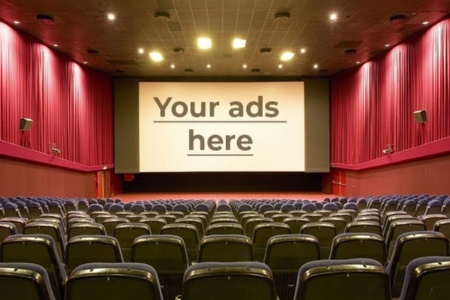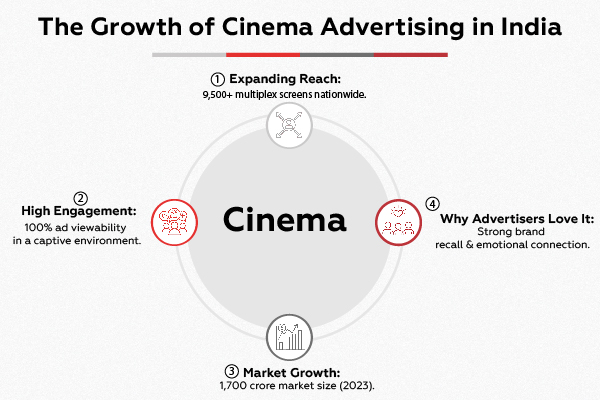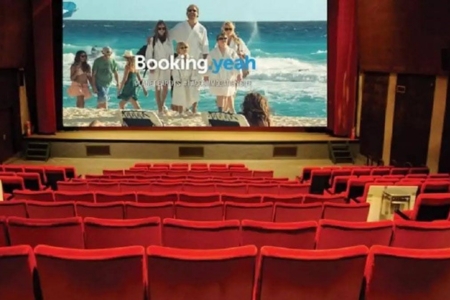Table Of Content

India’s cinema industry is booming, and with it, cinema advertising has emerged as a powerful tool for brands. From urban multiplexes to rural single screens, advertisers have found new ways to connect with audiences. Understanding facts about cinema advertising can help brands make better decisions about where and how to advertise.
The Growth of Cinema Advertising in India

India’s love for movies is undeniable. The growth of theaters, especially multiplexes, has expanded opportunities for brands. Knowing cinema advertising rates and the options available ensures effective campaigns.
Expanding Audience Reach

The reach of cinema advertising has grown significantly, thanks to multiplexes in cities and thriving regional cinema in smaller towns. A deep dive into facts about cinema advertising reveals its ability to connect with India’s diverse audience base. The rise of luxury cinemas and regional films makes it easier to target specific demographics effectively.
Digitalization’s Influence on Cinema Advertising
Digital screens have revolutionized the types of cinema advertising brands can choose from. They enable sharper visuals and dynamic content, making advertisements more engaging. As cinema advertising rates for premium formats like IMAX or 3D rise, advertisers need to weigh the cinema advertising cost against potential returns.
Types of Cinema Advertising in India

Understanding the types of cinema advertising available is key to creating successful campaigns. Each format serves a unique purpose, allowing brands to target audiences based on their goals.
1. Traditional On-Screen Advertising
This classic method involves showing ads before the movie starts. With cinema advertising rates depending on location and theater type, brands can tailor their campaigns to fit their budgets. These ads are a staple for anyone exploring the types of cinema advertising.
2. Digital and Interactive Advertising
Digital screens have introduced new types of cinema advertising like interactive campaigns. These ads engage audiences directly through mobile apps or QR codes. Though this can increase the cinema advertising cost, it offers higher engagement rates.
3. In-Theater Branding and Sponsorships
From popcorn boxes to theater walls, in-theater branding offers creative ways to advertise. While these types of cinema advertising might seem unconventional, they are highly effective in capturing audience attention. The cinema advertising cost here varies widely, depending on the space and level of customization.
The Benefits of Cinema Advertising in India

The immersive environment of theaters gives cinema ads a unique edge. However, brands must balance the cinema advertising cost with the potential benefits to maximize ROI.
1. High Engagement and Attention
One of the most important facts about cinema advertising is its ability to capture undivided attention. In a dark, distraction-free environment, ads have a stronger impact compared to digital or TV ads.
2. Reaching a Diverse Audience
The diverse audience in India is another reason brands flock to theaters. Regional films, in particular, offer opportunities to reach specific demographics. Knowing the cinema advertising rates for different regions can help brands allocate their budgets effectively.
Cinema Advertising’s Role in the Indian Entertainment Ecosystem

Cinema ads are not just standalone tools; they contribute significantly to the larger entertainment ecosystem.
1. Synergy with Film Promotions
Brands often collaborate with films for mutual promotion. For example, movie-themed ads or campaigns featuring actors from popular films. This is one of the more creative types of cinema advertising that drives excitement for both the brand and the movie.
2. Integration with Digital Platforms
Cross-promotion between theaters and OTT platforms is a rising trend. Brands use this synergy to amplify their message. When planning such campaigns, understanding the cinema advertising cost helps in creating a balanced strategy.
The Challenges of Cinema Advertising in India
Despite its advantages, cinema advertising has its challenges.
1. Regional Diversity and Localization
India’s diversity requires brands to customize ads for various audiences. This adds to the cinema advertising cost, as multiple versions of the ad may need to be produced.
2. Infrastructure and Cost Barriers
The cinema advertising rates for premium locations in metro cities can be high, making it a challenge for smaller brands. Meanwhile, rural theaters might lack the infrastructure to support high-quality ads, adding to the complexity.
Future Trends in Cinema Advertising in India
The future of cinema advertising lies in innovation and better targeting. Brands that stay ahead of trends can optimize their campaigns while keeping cinema advertising cost under control.
1. Programmatic and Data-Driven Advertising
Data analytics is helping brands refine their campaigns. Programmatic advertising allows real-time changes to ad placement, improving efficiency. The flexibility comes with variable cinema advertising rates, making it essential to plan budgets carefully.
2. 3D and VR in Ads
The adoption of immersive technologies like 3D and VR is introducing cutting-edge types of cinema advertising. These formats create engaging experiences, though they might come with a higher cinema advertising cost.
To make the most of cinema advertising, partnering with an experienced advertising agency like Excellent Publicity is essential. Agencies bring valuable expertise in campaign planning, media buying, and creative execution, ensuring that your brand message reaches the right audience effectively.
FAQs
One of the key facts about cinema advertising is its ability to engage audiences in an immersive setting. The lack of distractions ensures ads are remembered.
Brands analyze audience preferences and tailor their campaigns accordingly. Understanding cinema advertising rates in different regions helps optimize budgets for better targeting.
Cinema advertising cost varies based on location, theater type, and ad duration. Multiplexes in metro cities charge higher cinema advertising rates, while single screens in smaller towns are more affordable.
Digital screens and programmatic placements have introduced new types of cinema advertising that are dynamic and interactive. These advancements, however, often come with higher cinema advertising cost.
One challenge is localizing content to appeal to diverse audiences. This increases the cinema advertising cost but is necessary for effective campaigns.
Cinema ads offer unmatched audience engagement but can have higher cinema advertising rates compared to TV or online ads. However, their effectiveness often justifies the investment.



